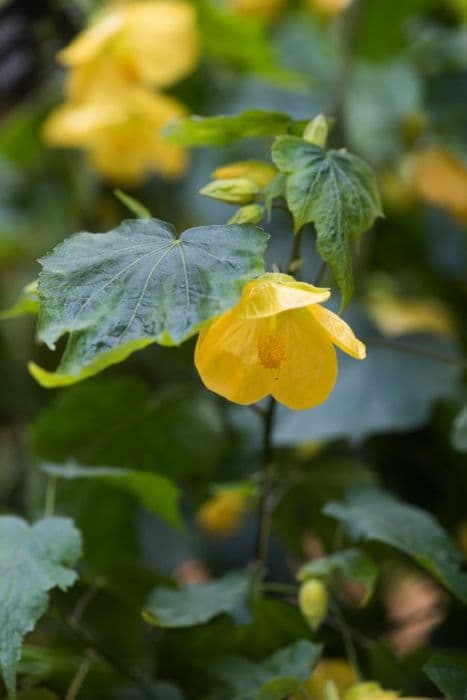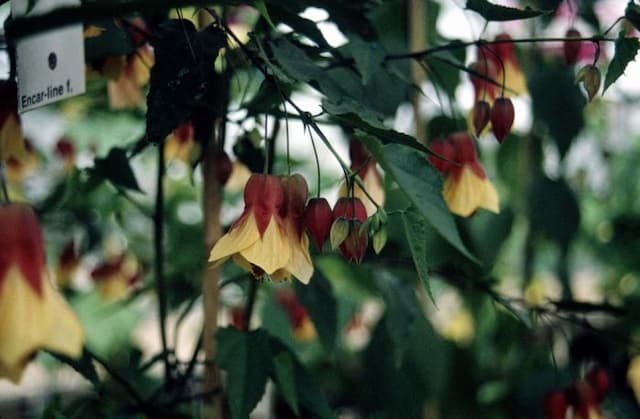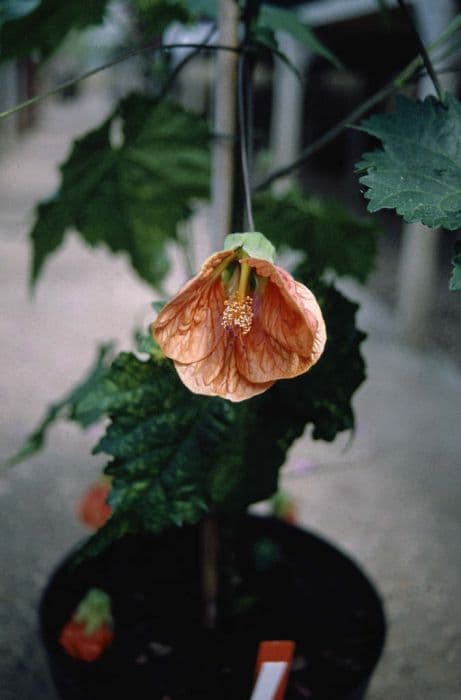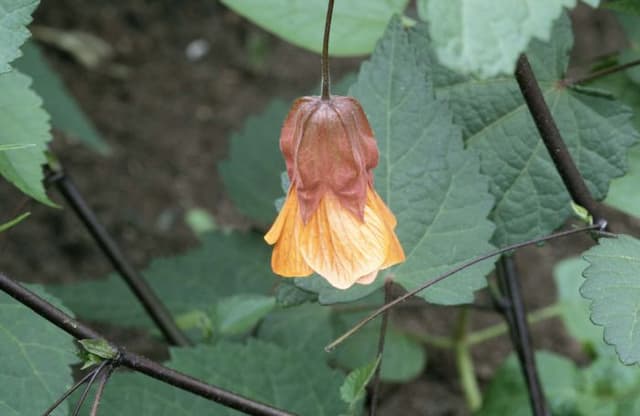Rose of Sharon Hibiscus syriacus China Chiffon = 'Bricutts' (Chiffon Series) (d)
![rose of Sharon [China Chiffon]](/_next/image?url=https%3A%2F%2Fplants-admin.emdemapps.com%2Fimages%2Fplants%2F%2Fimages%2F604b5ebd4d4e2.png&w=3840&q=75)
ABOUT
The Hibiscus syriacus China Chiffon, commonly known as the Rose of Sharon, is distinguished by its ornamental appeal, largely characterized by its beautiful flowers. The plant blooms with semi-double flowers, each showcasing a delicate and intricate texture emblematic of the 'Chiffon Series.' Each flower presents a soft, pastel hue, with variations often in the light pink to lavender spectrum, and sometimes with a hint that leans towards blue. At the core of the flowers, there is a striking contrast provided by the darker, more prominent center, which is typically a burgundy or red eye that captures the gaze and draws attention to the heart of the bloom. Around this center, the petals are ruffled and layered, emanating outwards and creating a lush, full appearance that is reminiscent of chiffon fabric, hence the name. The foliage of the Rose of Sharon provides a verdant backdrop to these stunning flowers. The leaves are sizable and somewhat triangular, with a dark green color that creates a dense, leafy silhouette throughout the growing season. The overall look of the plant is one that offers a splendid display of floral exuberance punctuated by deep green foliage. Its appearance strikes a balance between the plant's lush, leafy character, and the delicate, showy blossoms that make it a favorite among ornamental shrubs.
About this plant
 Names
NamesFamily
Malvaceae.
Synonyms
Rose of Sharon, Chinese Hibiscus, Syrian Ketmia, Shrub Althea, Hardy Hibiscus.
Common names
Hibiscus syriacus 'Bricutts'.
 Toxicity
ToxicityTo humans
The plant in question, commonly known as Rose of Sharon, is not considered toxic to humans. There have been no significant reports of poisoning or toxic reactions from ingesting parts of the Rose of Sharon plant. While it is not advisable to consume plant material that is not specifically intended for human consumption, accidental ingestion of Rose of Sharon is unlikely to result in severe consequences.
To pets
For pets, the Rose of Sharon is similarly non-toxic. There is no well-documented evidence to suggest that ingestion of Rose of Sharon poses a significant threat to the health of pets. However, while not specifically poisonous, consuming plant material can sometimes lead to mild gastrointestinal upset in some pets due to the non-digestible nature of certain plant fibers. If a pet was to ingest a large amount of Rose of Sharon, they may experience symptoms such as vomiting or diarrhea, but these symptoms are more likely due to the physical irritation of the stomach rather than chemical toxicity.
 Characteristics
CharacteristicsLife cycle
Perennials
Foliage type
Deciduous
Color of leaves
Green
Flower color
Pink
Height
8-12 feet (2.4-3.7 meters)
Spread
4-6 feet (1.2-1.8 meters)
Plant type
Shrub
Hardiness zones
5-8
Native area
East Asia
Benefits
 General Benefits
General Benefits- Ornamental Value - Hibiscus syriacus 'China Chiffon' is appreciated for its large, showy blooms that enhance the aesthetics of gardens and landscapes.
- Drought Tolerance - Once established, it is quite drought-tolerant, requiring less frequent watering and conserving water resources.
- Wildlife Attraction - The flowers attract pollinators like bees and butterflies, supporting local ecosystems.
- Low Maintenance - It requires minimal care beyond the initial planting and establishment period, making it ideal for low-maintenance landscapes.
- Privacy Screen - With its bushy growth habit, it can provide a natural privacy screen or hedge when planted in a row.
- Shade Tolerance - It can grow well in partial shade, making it versatile for different planting locations.
 Medical Properties
Medical PropertiesThis plant is not used for medical purposes.
 Air-purifying Qualities
Air-purifying QualitiesThis plant is not specifically known for air purifying qualities.
 Other Uses
Other Uses- Paper production: The bark of the rose of Sharon, especially when sourced from older shrubs, can be used to make a variety of paper products.
- Edible blooms: The flowers of the rose of Sharon are edible and can be used to add a floral touch to salads or as an eye-catching garnish on desserts and drinks.
- Natural fabric dye: The petals of the rose of Sharon can produce a delicate dye for fabrics, yielding soft hues suitable for textiles and artisan crafts.
- Landscaping: As a hardy and attractive plant, rose of Sharon is often used for landscape design in hedges, garden borders, or as a focal point in ornamental gardens.
- Insect attractor: The flowers of the plant can be used to attract pollinators like bees and butterflies, enhancing the biodiversity and health of a garden.
- Leaf pigment for art: Similar to the flowers, the leaves can be crushed to extract a green pigment suitable for natural inks or paints for art projects.
- Interiors: Cut branches of the rose of Sharon can be brought indoors and used in floral arrangements to brighten interior spaces.
- Symbolism: In some cultures, the rose of Sharon is considered a symbol of beauty and can be given as a gift for its symbolic meaning.
- Photography: Its vibrant flowers make the rose of Sharon a popular subject for photography, capturing the essence of late summer blooms.
- Teaching tool: The plant can serve as an educational specimen in botany and horticulture classes, illustrating principles of plant growth and care.
Interesting Facts
 Feng Shui
Feng ShuiThe Rose of Sharon is not used in Feng Shui practice.
 Zodiac Sign Compitability
Zodiac Sign CompitabilityThe Rose of Sharon is not used in astrology practice.
 Plant Symbolism
Plant Symbolism- Delicate Beauty: The Hibiscus syriacus, commonly known as Rose of Sharon, often symbolizes delicate beauty because of its large, showy flowers and soft, chiffon-like petals which are associated with feminine elegance.
- Femininity: With its soft, graceful appearance, the Rose of Sharon is frequently associated with women's beauty and gentle charm.
- Consumed by Love: In South Korea, where the Rose of Sharon is the national flower, it represents the enduring nature of love. The flower's ability to withstand harsh environments symbolizes the strength of love through adversity.
- New Beginnings: Blooming in late summer, the Rose of Sharon signifies new beginnings and rebirth, as it is one of the last flowers to bloom before the onset of autumn.
 Water
WaterRose of Sharon should be watered deeply, ensuring that the roots are well hydrated, about once or twice a week depending on the weather and soil conditions. During hot summer months, check the soil moisture frequently as it may require more frequent watering, potentially increasing to two or three times a week. It is important to avoid overwatering, which can lead to root rot. A general rule is to provide about 1-2 gallons of water weekly, increasing the amount during periods of extreme heat or drought. Always allow the top inch of soil to dry out between waterings to ensure you are not overwatering the plant.
 Light
LightRose of Sharon thrives in full sunlight, requiring at least six hours of direct sunlight each day for optimal growth and flowering. The best spot for the plant would be in an area with unobstructed exposure to sunlight, which could include a sunny border or an open garden space. While it can tolerate partial shade, too little sunlight will result in fewer flowers and a leggier plant.
 Temperature
TemperatureRose of Sharon is hardy and can tolerate a wide range of temperatures, thriving well in regions with temperatures as low as -20°F and as high as 100°F. The ideal temperature for optimal growth ranges from 60°F to 85°F. It is essential to protect the plant from frost, but it can survive a cold winter if properly mulched and cared for, showing good resilience in colder climates.
 Pruning
PruningRose of Sharon should be pruned in late winter or early spring before new growth begins to maintain a desired shape and to encourage bushier growth and more flowers. It can also be pruned after blooming to remove spent blooms and to prevent unwanted self-seeding. Pruning involves removing dead, damaged, or crossing branches, and can also include cutting back one-third of the older stems to rejuvenate the plant.
 Cleaning
CleaningAs needed
 Soil
SoilRose of Sharon thrives in well-draining soil enriched with organic matter. A mix consisting of two parts loam, one part peat, and one part sand can create an ideal growing medium. The soil pH should be between 5.5 to 7.5. Regular mulching helps to maintain soil moisture and temperature.
 Repotting
RepottingRose of Sharon typically does not need frequent repotting. It can be repotted every 3 to 5 years, depending on its growth. In containers, ensure repotting is done when the plant becomes root-bound or the soil is depleted.
 Humidity & Misting
Humidity & MistingRose of Sharon prefers moderate humidity levels but it is quite adaptable to different humidity conditions typically found in temperate climates. It can tolerate high humidity as long as there is good air circulation.
 Suitable locations
Suitable locationsIndoor
Ensure bright light; water when soil feels dry.
Outdoor
Plant in sun, amend soil, water regularly.
Hardiness zone
5-8 USDA
 Life cycle
Life cycleHibiscus syriacus 'China Chiffon', commonly known as Rose of Sharon, begins its life as a seed, which under proper conditions of warmth and moisture, germinates and emerges as a seedling. The plant then enters a vegetative stage, where it focuses on leaf growth, developing a strong root system and woody stems over time. During spring and summer, it enters the flowering stage, where it produces large, showy blooms, often attracting pollinators such as bees and butterflies. After pollination, the flowers give way to seed pods which ripen in late summer or fall, completing the plant's reproductive cycle. Throughout the seasons, the plant can undergo periods of dormancy, particularly in colder climates where it sheds leaves and remains inactive through the winter. As a perennial shrub, Hibiscus syriacus 'China Chiffon' can live for many years, repeating this cycle annually.
 Propogation
PropogationPropogation time
Late spring to early summer
The most popular method of propagating the Rose of Sharon China Chiffon variety is through softwood cuttings. This process involves cutting a young shoot from the parent plant, approximately 4-6 inches long (10-15 cm), during the late spring or early summer when the plant's growth is most vigorous. Choose a healthy stem with leaves, but remove the lower leaves before planting the cutting in a well-draining soil mix. To encourage root growth, the base of the cutting can be dipped in rooting hormone before planting. The soil should be kept consistently moist, but not waterlogged, and the cutting should be placed in a warm, bright area but out of direct sunlight until roots have developed, generally within 4 to 8 weeks. Once the cutting has established a strong root system, it can be transplanted to a more permanent location in the garden.





![Abutilon [Yellow Trumpet]](/_next/image?url=https%3A%2F%2Fplants-admin.emdemapps.com%2Fimages%2Fplants%2F%2Fimages%2F604b5caa8b4fb.png&w=640&q=75)


